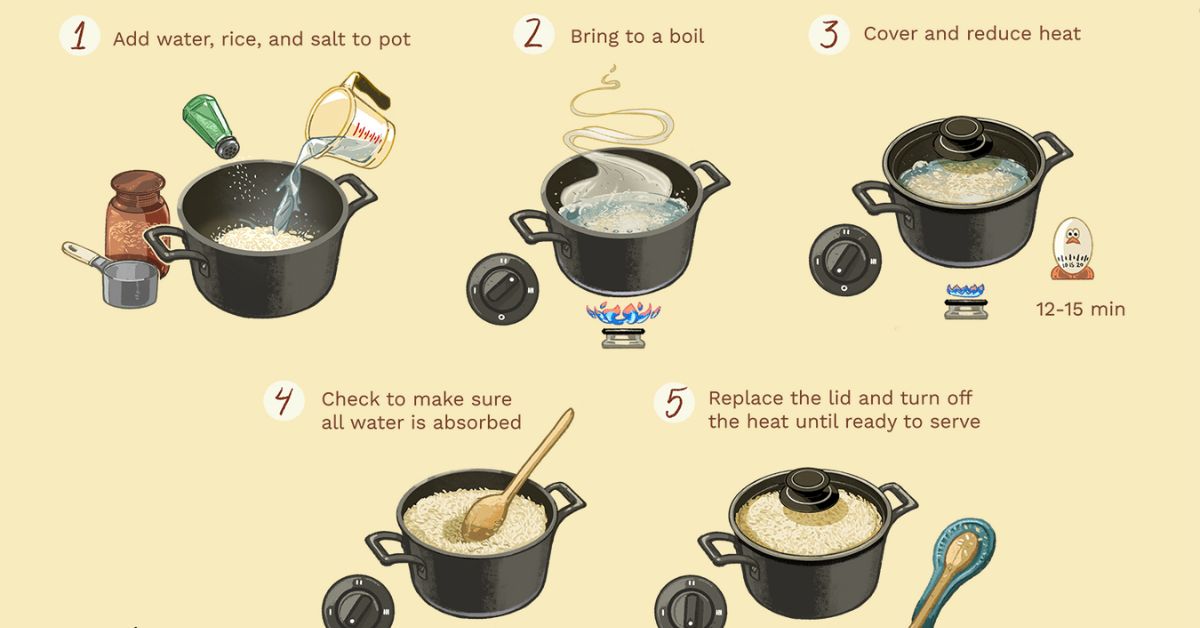How To Cook Jasmine Rice

Jasmine rice is a type of long-grain rice known for its scented aroma and fragile flavor. It originates from Thailand and is ordinarily used in Asian cuisines in dishes like stir fries as well as curries, and sushi.
The grains were slimly steamy when cooked, making it ideal for dishes where grain is essential. Discover the redolent bask of jasmCooking jasmine rice in rice and a cookery gem prized for its mincing posy and new texture, Originating from Thailand.
Let jasmine rice be the Rapid basis of your preferred dishes with pernicious floral notes and soft, soft grains that debilitate the meat of Jasmine rice. It is a primary ferment that starts with rinsing the rice under cold water to abstract surplus starch.
The rice with water in a pot with a tight-fitting lid, using a ratio of 1 cup of rice to 1.5 cups of water. Bring the premix to a boil, then declare the heat to low and simmer for about 15 to 20 transactions until the water is absorbed and the rice is tender. Fluff the cooked rice with a fork before serving.
What Is Jasmine Rice?
Jasmine rice is an eccentric type of long-grain rice that originates from Thailand. Its well-defined aroma, redolent of jasmine flowers, adds a delicious touch to single dishes. With its soft grain and pernicious flavor, jasmine rice is a standard option in Asian gastronomical and beyond, making it a various canonic in many kitchens.
Jasmine Rice vs. Basmati Rice

There are illustrious differences in aroma, texture, and flavor comparing jasmine rice to basmati rice. Jasmine rice, with its pernicious flowered scent and slimly steamy texture complements dishes like stir fries and curries.
Basmati rice, on the other hand, was known for its long grains as well as nutty aroma, and soft texture, making it a first class option for biryanis and pilafs. Each change brings its unequaled characteristics to the table, catering to clear-cut cookery preferences and recipes.
How to Make Jasmine Rice

Making jasmine rice is a straight ferment that begins with rinsing the rice under cold water to extract surplus starch.
Then, I aggregated one cup of rice with one and a half cups of water in a pot with a tight-fitting lid. Bring the premix to a boil,, then declare the heat to low and simmer for about 15 to 20 minutes until the water is absorbed and the rice is tender. Fluff the cooked rice with a fork before serving to check a light and soft texture.
Jasmine Rice to Water Ratio

Use a 1 to 1.5 ratio of rice to water to read jasmine rice. This way, for a complete cup of rice, use 1.5 cups of water. Rinse the rice before cooking to abstracted surplus starch. Follow boxful instructions for best results. Enjoy soft and redolent jasmine rice.
Ingredients
- Rice: Basmati or any other change of rice.
- Water: Used for cooking the rice.
- Salt: Adds a feeling to the rice.
- Optional: Rhee or oil for added grandness and flavour.
How Long to Cook Jasmine Rice
To cook jasmine rice, bring water to a boil. Add the rice and declare the heat to low. Cover and simmer for 15 to 20 minutes. Fluff with a fork and serve hot.
Directions
Follow these easy directions to cook jasmine rice
- Rinse the rice under cold water to remove starch.
- Combine 1 cup of rice with 1.5 cups of water in a pot.
- Bring the water to a boil, then declare heat to low and cover.
- Simmer for 15 to 20 transactions until the rice is new and fluffy. Fluff with a fork before serving.
Stovetop Method
The stove top commercial is a primary way to cook jasmine rice. Start by rinsing the rice under cold water to abstract surplus starch. After that, combine 1 cup of rice and 1.5 cups of water in a pot. Bring the water to a boil over medium heat. Once boiling, declare the heat to low, cover the pot, and let the rice simmer for 15 to 20 minutes until tender and fluffy. Fluff the rice with a fork before serving. This stove top commercial yields dead cooked jasmine rice every time.
Pressure Cooker Method
To cook jasmine rice using the cooker method, rinse the rice under cutting pee to abstract nicety starch. Then, add 1 cup of rice and 1.5 cups of pee to the squeeze cooker. Close the lid and set the cooker to high-pitched squeeze for 3 minutes.
Once the cooking time is up, allow the force to free course for 10 transactions before opening the lid. Fluff the rice with a fork and serve hot. This quick and spacious commercial yields dead-cooked jasmine rice every time.
How to Cook Jasmine Rice in the Microwave

To cook jasmine rice in the microwave, rinse 1 cup of rice under cold water to abstract surplus starch. Then, place the rice in a microwave-safe bowl and add 1.5 cups of water. Cover the bowl with a microwave-safe lid or plate.
The microwave is on high for 10 minutes, then let it sit for 5 transactions before fluffing with a fork. The rice should have been new and fluffy. Adjust cooking time if needed based on zap wattage. This quick commercial is romantic for a fast and easy meal.
Tips for Cooking Jasmine Rice
- Rinse the rice under cold water before cooking to abstract surplus starch.
- Use a 1 to 1.5 ratio of rice to water for soft results.
- Let the rice rest for a few transactions after cooking to allow it to steam and become more tender.
- Fluff the rice with a fork before serving to differentiate the grains and heighten the texture.
conclusion
Mastering the art of cooking jasmine rice is manageable by using single methods such as stovetop, microwave, force cooker, or rice cooker. Regardless of the technique, rinsing the rice, using the correct rice-to-water ratio, and allowing it to rest after cooking are base steps to check the results of soft and rapid.
With these easy-to-follow tips and techniques, anyone can confidently grow scrumptious jasmine rice to accompany their preferred dishes. Whether it is a primary weeknight meal or an exceptional occasion, cooking jasmine rice dead every time is within reach. It enhances the boiler suit dining with its fragile aroma and delicious grain.







